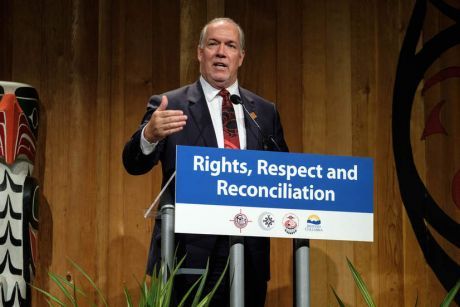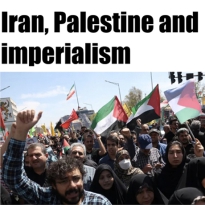Features
You are here
Why does the NDP keep betraying Indigenous peoples?

January 22, 2018
“I am not the first person to stand before you and disappoint indigenous people.” This was how BC Premier Horgan described the NDP’s support for Site C dam, which betrayed their election promise and Indigenous rights. As Grand Chief Stewart Phillip of the Union of BC Indian Chiefs explained, “a project approval will represent a complete betrayal of First Nation's and the vast majority of British Columbians who stand in steadfast opposition to the Site C dam project…With every court case, every delay, every budget lift, and every rate hike, we will remind British Columbians that it may have been the BC Liberals that got us into this mess, but it was the BC NDP who chose to abandon us there.”
The NDP is the only major party connected to the labour movement, and in voting for it many people hope the NDP won’t be as damaging as the corporate Liberals and Conservatives. This was especially true for the recent BC election, which saw the NDP prevail over the hated Liberals. But the recent approval of the Site C dam by the BC NDP is not the first time the NDP has betrayed indigenous peoples. Instead, Horgan made reference to a long legacy while committing himself to continuing it.
Colonialism and Indigenous suffrage
The Canadian state is based on the violent suppression of Indigenous sovereignty and for the first century of its existence it used the vote as a colonial tactic—offering it as the price to pay for relinquishing Indian status, or as a temporary measure to mobilize Indigenous soldiers. After the war the Liberal government of St-Laurent discussed Indigenous suffrage, but cabinet minister CD Howe feared it would benefit the CCF, which had attracted some Indigenous activists. It was only in 1960 under the Conservative Diefenbaker government that Indigenous people were allowed to vote, and this came in the context of continued forced assimilation—from ongoing residential school genocide, to the “60s scoop” that removed Indigenous children from their communities, to Pierre Trudeau’s “White Paper” in 1969 that proposed ending Indian status.
For this reason some Indigenous activists, like Cree leader John Tootoosis (whose great uncle Chief Poundmaker was incarcerated for challenging the early Canadian state in 1885) opposed the vote as a ploy to ignore treaties. Other activists, like Metis socialist Howard Adams (whose grandfather Maxime Lepine was also incarcerated in 1885) saw the vote as a tactic that Indigenous people could be used to raise the issue of sovereignty.
1960-70s: Red Power
As an expression of workers opposition to capitalist parties, a social democratic party in Canada (first the CCF and then its offspring the NDP) was important to win reforms like Medicare. But its goal is to use the state to provide reforms, not challenge its colonial and capitalist foundations. As a result, while the early 1960s produced both the NDP and Indigenous suffrage, the new party did not mobilize Indigenous voters as CD Howe had feared.
As Howard Adams explained, “the Saskatchewan Native Action Committee (SNAC) ran independent candidates in the 1968 federal election. Several leading Aboriginal spokespersons were opposed to this action. They argued that because Indians had been excluded from voting until 1961, there was no reason why they should become involved now…We understood that political parties were intimately connected to the capitalist system that impoverished our people. For this reason, we believed that all parties, Conservatives, Liberals, and NDP, were incapable of making real changes. They could only make minor reforms that would never provide lasting benefits to Indians and Metis. Therefore, SNAC’s candidate, Carole Lavalee of the Cowesses reserve, ran as an independent…A couple of Aboriginals had been elected to Parliament before, but as a Liberal or Conservative member. They had done nothing to advance their people’s needs, nor had they promoted self-determination. In short, they were indistinguishable from white MPs. Our candidate’s election platform broke with this tradition. Her campaign for Aboriginal people was based on two central issues: self-determination and autonomous control of our local industries and Native communities”
The next year the Red Power movement emerged, sparked by the White Paper, but the NDP did not embrace it. The Dene Peoples were fighting for their rights when the MacKenzie Valley pipeline was being proposed. During the Berger inquiry into the pipeline, at a meeting in Winnipeg, home to a large Indigenous community, the Manitoba NDP declined to make a submission, for fear of offending business. “Silence is consent” accurately describes this failure. In 1972, BC elected its first NDP government and Premier Dave Barrett thought he was doing the right thing by appointing Nisga’a leader Frank Calder to his cabinet. But Calder was given no portfolio; this was tokenism supreme.
1990s activism
In the late 1980s and early 1990s there was another wave of Indigenous land defense from coast to coast—from Innu blockade of a NATO base in Labrador, to Mohawks defending sacred land at Kanesatake, to Algonquins of Barriere Lake challenging clear-cutting, to the occupation of Ipperwash Park, to Sundancers asserting their ceremonial rights at Ts’Peten (Gustafsen Lake). In government again in BC, the NDP spent the 1990s defending land grabs through colonial courts and armed police—while also legislating striking teachers back to work.
The BC NDP government professed to be moving beyond the overtly racist and exploitive practices of decades of Social Credit/Liberal governments who refused to recognize indigenous land title. The NDP created treaty tables to negotiate “certainty” in a province where no treaties were in place. But these “treaties” relied on the governments (federal and provincial) extinguishing the land title of First Nations, then negotiating some of the land back into the control of each participating First Nation. In other words, the government formalizes its robbery of the lands, then gives a little bit back, plus some cash. Twenty-five years after the BC treaty process began, very few treaties have been signed and the First Nations involved have run up debts of some $500 million to pay for the lawyers, scientists and consultants who have to make their case to the governments.
When it came to Sundancers conducting ceremonies on their land, the BC NDP responded with the largest RCMP operation in history. Attorney General Ujjal Dosanj made the shocking statement “Where’s the other side of the story? There is only one side of the story. There is no other side.” In other words, the Sundancers had no right to speak about the site or about indigenous rights more broadly. And when the RCMP alleged they had been shot at (a charge later shown to be a fabrication, but consistent with the RCMP’s smear campaign), Dosanj used this as a pretext to have the Department of National Defense send in armoured personnel carriers and other equipment including land mines that were set around the camp.
Idle No More and climate justice
Facing the latest wave of Indigenous resistance, the NDP leadership took the side of “law and order.” Concurrent with the launch of Idle No More in late 2012, Attawapiskat Chief Theresa Spence conducted a fast on Victoria Island, across from “Parliament Hill.” Her community had only recently been in the news for appalling housing conditions. Support came from everywhere, both Indigenous and non-Indigenous. The Canadian Union of Postal Workers (CUPW) issued a public letter of support for her and for Indigenous sovereignty. In contrast to CUPW’s letter of support, NDP leader Tom Mulcair called on the Chief to suspend her hunger strike, saying “the government seems to be moving so I think that the best thing to do would be to step back from that now.” The next year, when Elsipogtog was building Indigenous-settler solidarity to stop testing which could have led to massive fracking in New Brunswick, the leadership of the New Brunswick NDP called for “the rule of law” to remove all blockades, and defended the “investment and jobs” falsely promised by the fracking industry.
Criticizing Indigenous resistance has been part of supporting the ongoing colonization of Indigenous territories. When the NDP was elected in Alberta in 2015 there was hope for a new era. “As First Nations we are optimistic to finally have a government that recognizes and respects Indigenous rights and territories,” wrote the Athabasca Chipewyan First Nation. But Notley’s first call was to reassure Big Oil that things would be “A-OK,” and the NDP leader has become a major defender of tar sands that pollute Indigenous territories—which the party replicated federally. In 2012 NDP energy critic Peter Julian supported the notion of a refinery on the west coast of BC to treat the bitumen that would be transported there from the oil sands, in the interests of “job creation.” And as noted in the Globe &Mail at the time, “In a speech aimed at easing fears that his party is opposed to oil sands development, Mr. Mulcair said shipping western oil to Eastern Canada is a ‘pro-business, common sense solution’ that will create jobs and boost the country’s energy security. Mr. Mulcair later told reporters he has long said he would not speak against the oil sands expansion.” Refusing to support climate justice, while promising “balanced budgets,” Mulcair allowed Trudeau to tack left with progressive rhetoric and win the federal election.
Last month Cree NDP MP Romeo Saganash re-introduced a private member’s bill to make the UN Declaration on the Rights of Indigenous Peoples (UNDRIP) part of Canadian law, and during his leadership campaign Jagmeet Singh opposed pipelines for not respecting UNDRIP. But when it represents the Canadian state, the NDP reflects its colonial foundations. Despite the fact the BC NDP has said it will do everything it can to stop the despised Kinder Morgan TransMountain pipeline, and even though it joined in the suite of court cases in 2017 to stop the pipeline, it also has a lawsuit against the Squamish First Nation, defending a decision by the previous Liberal government to approve the pipeline. Squamish Chief Ian Campbell exposed the discrepancy: "When the NDP got into office, they were quite vocal about this issue. The response we are getting now is that they will challenge our position. It makes us wonder where the province stands." At the same time the NDP government has gone against the expressed wishes of First Nations and others to approve the giant Site C dam, and in the latest development, the NDP is openly supporting the liquid natural gas (LNG) industry. In January 2018, Premier Horgan spoke at the Natural Resources Forum in Prince George and is reported by the CBC to have presented himself “as a champion of B.C.’s resource industry… He will confirm his openness to a proposed LNG export terminal in Kitimat, B.C.”
Reform or revolution
This is another betrayal, and one built into the NDP and which exposes its contradictions. The Liberals and Tories don’t betray because their corporate masters never had any intention of respecting Indigenous sovereignty. But alone among the major political parties, the NDP is not supported by big business. The party’s resolutions, put forth by NDP activists involved in movements, support the working class and Indigenous rights—for example, members are pushing the party to support the Leap Manifesto. But because of its electoralist strategy, the party leadership subordinates these to the needs to be “electable” and thus cater to business interests. When elected to government, the NDP repeatedly turns its back on the working class and on indigenous rights. The NDP behaves like all social democratic parties around the world—to prop up capitalism, not overthrow it. In the context of a colonial settler state, this reformist strategy leads the NDP to chose the Canadian state over Indigenous sovereignty.
From Red Power to Idle No More, movements for Indigenous sovereignty expose the failures of the Parliamentary road to a better world, while building the solidarity needed to chart another path—intertwining Indigenous national liberation with working class revolution. As Howard Adams explained, “The New Democratic Party is very much like the other two bourgeois parties, except that it brings about small reforms in health, welfare, car insurance, etc.; it is equally a part of the capitalist system and therefore unable to bring about any real and basic changes in society. All governments regardless of their political affiliations have discriminated against native people and denied them their rights as full citizens. Parliament is an instrument of the ruling class and its main purpose is to support and protect the ruling class…Radical nationalism will mean greater class consciousness. It develops the understanding that a native liberation struggle is essentially the same struggle as that of the working class and all oppressed people against a capitalist ruling class. In this way, Indians and Metis can build alliances with workers and other oppressed and colonized groups of white society.”
Section:










